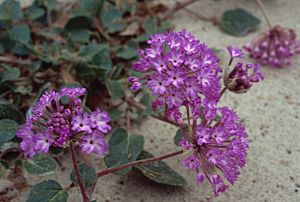Largefruit sand verbena facts for kids
Quick facts for kids Largefruit sand verbena |
|
|---|---|
 |
|
| Conservation status | |
| Scientific classification |
Abronia macrocarpa is a very rare flowering plant. It is commonly known as the largefruit sand verbena. This plant only grows in a small area of eastern Texas. You can find it in Freestone, Leon, and Robertson counties. It loves to grow in tough, open sand dunes in savannas, where the soil is deep and not very rich.
Scientists first found this plant in 1968. It was officially named a new species in 1972. Today, it is listed as an endangered species in the United States, which means it needs special protection to survive.
Contents
What is the Largefruit Sand Verbena?
The largefruit sand verbena is a perennial herb. This means it is a plant that lives for more than two years. It has a stem that can grow up to half a meter (about 20 inches) tall. This stem is often hairy and has tiny sticky parts called glands.
Its oval-shaped leaves can be up to 5 centimeters (2 inches) long and 3.5 centimeters (1.4 inches) wide. They grow on long stalks called petioles.
The flowers grow in a group called an inflorescence. There can be up to 75 bright magenta or light purple flowers in one cluster. Each flower is shaped like a tube and can be up to 3 centimeters (1.2 inches) long. These flowers have a strong smell and open when the sun goes down. Moths help to pollinate them, which means they carry pollen from one flower to another.
The plant also produces a winged fruit. This fruit can be up to 1.5 centimeters (0.6 inches) long. The wind helps to spread its seeds to new places.
This plant naturally grows in sandy soils where there isn't much other plant life. You can often find it in open areas within woodlands where post-oak trees grow.
Why is this Plant Endangered?
There are several reasons why the largefruit sand verbena is an endangered species:
- Habitat Loss: Its natural home is being taken over by new buildings and places where people look for oil.
- Damage to Habitat: Activities like driving off-road vehicles, walking, or riding horses can harm the sandy areas where it grows.
- Fire Control: Efforts to stop wildfires can also change the natural environment this plant needs.
- Invasive Plants: Other plants that are not native to the area, like bermudagrass and weeping lovegrass (Eragrostis curvula), are growing into its habitat and taking over.
Scientists believe there are only a few thousand individual plants left. These plants are found in about nine different groups.
Life Cycle
The largefruit sand verbena usually flowers between February and May. It often blooms after a lot of rain. Sphinx moths are important for pollinating these flowers. The plant releases its winged fruits during the summer months. After this, the plants may die back, but they often grow again in the fall.
Historical Uses
Long ago, Native Americans used parts of the largefruit sand verbena. They used the roots and leaves to help treat skin injuries. Sometimes, the roots were even mixed with cornmeal and eaten as food. Later, people used the flowers to make scented oils and to dye wool.


